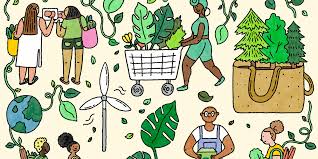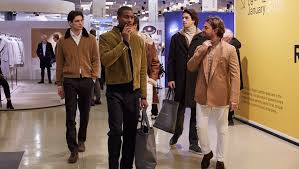As the global focus on sustainability intensifies, the fashion industry is undergoing a significant transformation. Men’s fashion, traditionally seen as less dynamic in terms of sustainability, is now embracing eco-friendly practices and innovative materials. In 2024, sustainable men’s fashion is not only about reducing environmental impact but also about embracing style, quality, and ethical production. This article explores the top sustainable men’s fashion trends for 2024, highlighting key innovations, brands, and practical tips for integrating sustainability into your wardrobe.
1. The Rise of Eco-Friendly Materials

1.1. Recycled and Upcycled Fabrics
- Overview: Recycled and upcycled fabrics are at the forefront of sustainable fashion. Brands are increasingly using materials like recycled polyester, nylon, and denim to reduce waste and minimize their environmental footprint.
- Benefits: Utilizing recycled materials helps reduce the demand for virgin resources and decreases the amount of textile waste that ends up in landfills.
1.2. Organic and Natural Fibers
- Overview: Organic cotton, hemp, bamboo, and Tencel are gaining popularity as sustainable alternatives to conventional fabrics. These materials are grown without harmful pesticides and often require less water and energy.
- Benefits: Organic and natural fibers are biodegradable, reducing their environmental impact compared to synthetic fabrics.
1.3. Innovative Alternatives
- Overview: Emerging materials such as mushroom leather (mycelium), pineapple leather (Piñatex), and seaweed-based fabrics are revolutionizing sustainable fashion.
- Benefits: These alternatives provide cruelty-free and environmentally friendly options that offer the same durability and aesthetic appeal as traditional materials.
2. The Shift Towards Circular Fashion
2.1. Upcycling and Repairing
- Overview: Upcycling involves repurposing old or discarded garments into new designs, while repair services extend the life of clothing.
- Trends: Many brands are now offering repair services or collaborating with artisans to upcycle worn-out pieces, turning them into unique, fashionable items.
- Benefits: Upcycling and repairing reduce waste and promote a more sustainable consumption model.
2.2. Rental and Subscription Services
- Overview: Clothing rental and subscription services allow men to enjoy a rotating wardrobe without the need for constant new purchases.
- Trends: Services like Rent the Runway and The Mr. Collection offer high-quality, fashionable clothing on a rental basis, catering to sustainability-conscious consumers.
- Benefits: Renting and subscribing minimize the need for excessive production and waste, aligning with the principles of circular fashion.
2.3. Take-Back Programs
- Overview: Some brands are implementing take-back programs, encouraging customers to return used items for recycling or repurposing.
- Trends: Companies like Patagonia and Nudie Jeans offer incentives for returning old garments, supporting a closed-loop system in fashion.
- Benefits: Take-back programs help keep textiles out of landfills and support the recycling of materials.
3. Ethical Production Practices
3.1. Fair Trade and Ethical Sourcing
- Overview: Ethical fashion emphasizes fair trade practices and responsible sourcing, ensuring that workers are paid fairly and work in safe conditions.
- Trends: Brands such as Everlane and People Tree are known for their commitment to transparent supply chains and ethical labor practices.
- Benefits: Fair trade and ethical sourcing promote social justice and improve the working conditions of garment workers.
3.2. Transparent Supply Chains
- Overview: Transparency in the supply chain allows consumers to trace the origins of their clothing and verify the sustainability of production processes.
- Trends: Brands like Allbirds and Veja provide detailed information about their supply chains, from raw material sourcing to manufacturing.
- Benefits: Transparency builds trust and encourages brands to adhere to higher environmental and ethical standards.
3.3. Reducing Carbon Footprints
- Overview: Many sustainable fashion brands are investing in practices to reduce their carbon footprint, such as using renewable energy and implementing energy-efficient processes.
- Trends: Brands like Stella McCartney and Reformation are leading the charge in carbon-neutral production and green logistics.
- Benefits: Reducing carbon emissions contributes to mitigating climate change and promoting a more sustainable future.
4. Minimalist and Timeless Designs

4.1. Emphasis on Quality Over Quantity
- Overview: Minimalist fashion focuses on high-quality, durable pieces that are versatile and timeless, reducing the need for frequent replacements.
- Trends: Brands like A.P.C. and COS are known for their minimalist designs that prioritize craftsmanship and longevity.
- Benefits: Investing in quality, timeless pieces reduces waste and supports a more sustainable approach to fashion consumption.
4.2. Neutral and Versatile Colors
- Overview: Neutral colors and versatile designs are central to minimalist fashion, making it easier to mix and match garments.
- Trends: Shades like beige, gray, and navy are popular, offering classic options that can be worn across seasons and occasions.
- Benefits: Neutral colors reduce the need for excessive buying and promote a more thoughtful wardrobe.
4.3. Functional and Multi-Use Pieces
- Overview: Functional clothing designed for multiple uses and occasions helps maximize the value of each garment.
- Trends: Brands are creating multi-functional pieces such as reversible jackets and convertible pants, enhancing versatility.
- Benefits: Multi-use garments reduce the need for excessive clothing and support a more sustainable approach to fashion.
5. Embracing Sustainable Accessories
5.1. Eco-Friendly Footwear
- Overview: Sustainable footwear options are becoming more prevalent, with brands focusing on recycled materials, natural fibers, and ethical production practices.
- Trends: Brands like Allbirds and Native Shoes are leading the way with eco-friendly sneakers and boots.
- Benefits: Sustainable footwear reduces environmental impact and supports ethical manufacturing practices.
5.2. Recycled and Upcycled Bags
- Overview: Bags made from recycled or upcycled materials offer both style and sustainability.
- Trends: Brands like Freitag and Patagonia create durable, fashionable bags from recycled fabrics and materials.
- Benefits: Using recycled materials for accessories reduces waste and promotes a circular economy.
5. Sustainable Jewelry
- Overview: Sustainable jewelry brands focus on ethical sourcing of materials, such as conflict-free gemstones and recycled metals.
- Trends: Brands like Brilliant Earth and Catbird are known for their commitment to responsible jewelry production.
- Benefits: Ethical jewelry practices reduce environmental harm and support fair labor conditions.
6. Practical Tips for Adopting Sustainable Men’s Fashion

6.1. Educate Yourself
- Overview: Understanding sustainable fashion principles and researching brands are crucial steps in making informed choices.
- Tips: Look for certifications, read brand stories, and familiarize yourself with sustainable materials and practices.
6.2. Build a Thoughtful Wardrobe
- Overview: Focus on quality, versatility, and timelessness when building your wardrobe. Prioritize pieces that align with sustainable fashion principles.
- Tips: Invest in well-made, durable items and avoid impulse purchases.
6.3. Care for Your Clothing
- Overview: Proper care and maintenance extend the life of your garments and reduce the need for replacements.
- Tips: Follow care instructions, repair items when needed, and use eco-friendly laundry products.
6.4. Support Sustainable Brands
- Overview: Choose to spend your money on brands that prioritize sustainability and ethical practices.
- Tips: Look for brands that are transparent about their supply chains, use eco-friendly materials, and support fair labor practices.
Conclusion
The rise of sustainable men’s fashion in 2024 marks a significant shift towards more ethical and eco-friendly practices within the industry. By embracing eco-friendly materials, supporting ethical production practices, and adopting minimalist designs, men can contribute to a more sustainable fashion future. As awareness and demand for sustainable fashion continue to grow, the industry will likely see further innovations and advancements, making it easier for consumers to make responsible choices. Adopting these trends not only benefits the environment but also enhances personal style and aligns with a more conscious way of living.


